Bin Fan
Autoregressive Image Generation with Linear Complexity: A Spatial-Aware Decay Perspective
Jul 02, 2025Abstract:Autoregressive (AR) models have garnered significant attention in image generation for their ability to effectively capture both local and global structures within visual data. However, prevalent AR models predominantly rely on the transformer architectures, which are beset by quadratic computational complexity concerning input sequence length and substantial memory overhead due to the necessity of maintaining key-value caches. Although linear attention mechanisms have successfully reduced this burden in language models, our initial experiments reveal that they significantly degrade image generation quality because of their inability to capture critical long-range dependencies in visual data. We propose Linear Attention with Spatial-Aware Decay (LASAD), a novel attention mechanism that explicitly preserves genuine 2D spatial relationships within the flattened image sequences by computing position-dependent decay factors based on true 2D spatial location rather than 1D sequence positions. Based on this mechanism, we present LASADGen, an autoregressive image generator that enables selective attention to relevant spatial contexts with linear complexity. Experiments on ImageNet show LASADGen achieves state-of-the-art image generation performance and computational efficiency, bridging the gap between linear attention's efficiency and spatial understanding needed for high-quality generation.
Instance-Level Moving Object Segmentation from a Single Image with Events
Feb 18, 2025Abstract:Moving object segmentation plays a crucial role in understanding dynamic scenes involving multiple moving objects, while the difficulties lie in taking into account both spatial texture structures and temporal motion cues. Existing methods based on video frames encounter difficulties in distinguishing whether pixel displacements of an object are caused by camera motion or object motion due to the complexities of accurate image-based motion modeling. Recent advances exploit the motion sensitivity of novel event cameras to counter conventional images' inadequate motion modeling capabilities, but instead lead to challenges in segmenting pixel-level object masks due to the lack of dense texture structures in events. To address these two limitations imposed by unimodal settings, we propose the first instance-level moving object segmentation framework that integrates complementary texture and motion cues. Our model incorporates implicit cross-modal masked attention augmentation, explicit contrastive feature learning, and flow-guided motion enhancement to exploit dense texture information from a single image and rich motion information from events, respectively. By leveraging the augmented texture and motion features, we separate mask segmentation from motion classification to handle varying numbers of independently moving objects. Through extensive evaluations on multiple datasets, as well as ablation experiments with different input settings and real-time efficiency analysis of the proposed framework, we believe that our first attempt to incorporate image and event data for practical deployment can provide new insights for future work in event-based motion related works. The source code with model training and pre-trained weights is released at https://npucvr.github.io/EvInsMOS
Pattern Matching in AI Compilers and its Formalization (Extended Version)
Dec 18, 2024



Abstract:PyPM is a Python-based domain specific language (DSL) for building rewrite-based optimization passes on machine learning computation graphs. Users define individual optimizations by writing (a) patterns that match subgraphs of a computation graph and (b) corresponding rules which replace a matched subgraph with an optimized kernel. PyPM is distinguished from the many other DSLs for defining rewriting passes by its complex and novel pattern language which borrows concepts from logic programming. PyPM patterns can be recursive, nondeterminstic, and can require checking domain-specific constraints such as the shapes of tensors. The PyPM implementation is thus similarly complicated, consisting of thousands of lines of C++ code. In this paper, we present our work on building PyPM, as well as formalizing and distilling and this complexity to an understandable mathematical core. We have developed a formal core calculus expressing the main operations of the PyPM pattern language. We define both a declarative semantics - describing which patterns match which terms - and an algorithmic semantics - an idealized version of the PyPM pattern interpreter - and prove their equivalence. The development is fully mechanized in the Coq proof assistant.
Boosting Gaze Object Prediction via Pixel-level Supervision from Vision Foundation Model
Aug 02, 2024Abstract:Gaze object prediction (GOP) aims to predict the category and location of the object that a human is looking at. Previous methods utilized box-level supervision to identify the object that a person is looking at, but struggled with semantic ambiguity, ie, a single box may contain several items since objects are close together. The Vision foundation model (VFM) has improved in object segmentation using box prompts, which can reduce confusion by more precisely locating objects, offering advantages for fine-grained prediction of gaze objects. This paper presents a more challenging gaze object segmentation (GOS) task, which involves inferring the pixel-level mask corresponding to the object captured by human gaze behavior. In particular, we propose that the pixel-level supervision provided by VFM can be integrated into gaze object prediction to mitigate semantic ambiguity. This leads to our gaze object detection and segmentation framework that enables accurate pixel-level predictions. Different from previous methods that require additional head input or ignore head features, we propose to automatically obtain head features from scene features to ensure the model's inference efficiency and flexibility in the real world. Moreover, rather than directly fuse features to predict gaze heatmap as in existing methods, which may overlook spatial location and subtle details of the object, we develop a space-to-object gaze regression method to facilitate human-object gaze interaction. Specifically, it first constructs an initial human-object spatial connection, then refines this connection by interacting with semantically clear features in the segmentation branch, ultimately predicting a gaze heatmap for precise localization. Extensive experiments on GOO-Synth and GOO-Real datasets demonstrate the effectiveness of our method.
Reusable Architecture Growth for Continual Stereo Matching
Mar 30, 2024



Abstract:The remarkable performance of recent stereo depth estimation models benefits from the successful use of convolutional neural networks to regress dense disparity. Akin to most tasks, this needs gathering training data that covers a number of heterogeneous scenes at deployment time. However, training samples are typically acquired continuously in practical applications, making the capability to learn new scenes continually even more crucial. For this purpose, we propose to perform continual stereo matching where a model is tasked to 1) continually learn new scenes, 2) overcome forgetting previously learned scenes, and 3) continuously predict disparities at inference. We achieve this goal by introducing a Reusable Architecture Growth (RAG) framework. RAG leverages task-specific neural unit search and architecture growth to learn new scenes continually in both supervised and self-supervised manners. It can maintain high reusability during growth by reusing previous units while obtaining good performance. Additionally, we present a Scene Router module to adaptively select the scene-specific architecture path at inference. Comprehensive experiments on numerous datasets show that our framework performs impressively in various weather, road, and city circumstances and surpasses the state-of-the-art methods in more challenging cross-dataset settings. Further experiments also demonstrate the adaptability of our method to unseen scenes, which can facilitate end-to-end stereo architecture learning and practical deployment.
ProIn: Learning to Predict Trajectory Based on Progressive Interactions for Autonomous Driving
Mar 25, 2024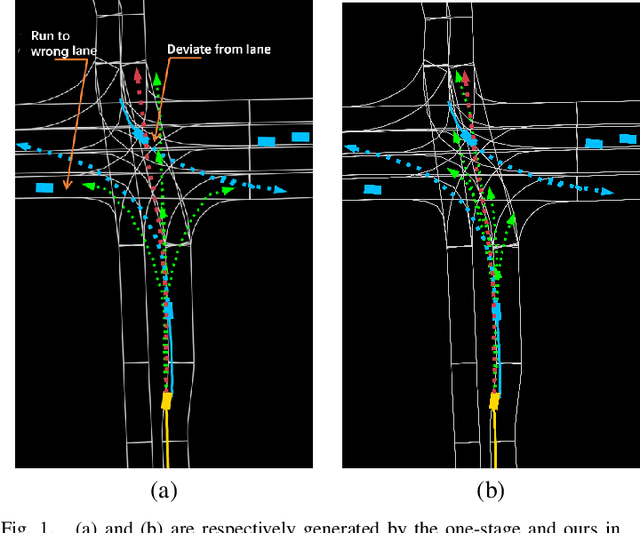


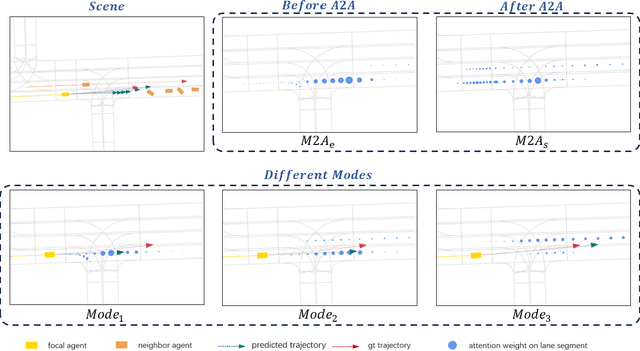
Abstract:Accurate motion prediction of pedestrians, cyclists, and other surrounding vehicles (all called agents) is very important for autonomous driving. Most existing works capture map information through an one-stage interaction with map by vector-based attention, to provide map constraints for social interaction and multi-modal differentiation. However, these methods have to encode all required map rules into the focal agent's feature, so as to retain all possible intentions' paths while at the meantime to adapt to potential social interaction. In this work, a progressive interaction network is proposed to enable the agent's feature to progressively focus on relevant maps, in order to better learn agents' feature representation capturing the relevant map constraints. The network progressively encode the complex influence of map constraints into the agent's feature through graph convolutions at the following three stages: after historical trajectory encoder, after social interaction, and after multi-modal differentiation. In addition, a weight allocation mechanism is proposed for multi-modal training, so that each mode can obtain learning opportunities from a single-mode ground truth. Experiments have validated the superiority of progressive interactions to the existing one-stage interaction, and demonstrate the effectiveness of each component. Encouraging results were obtained in the challenging benchmarks.
Defying Imbalanced Forgetting in Class Incremental Learning
Mar 22, 2024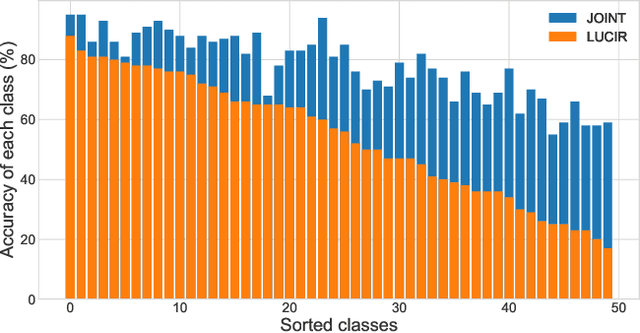

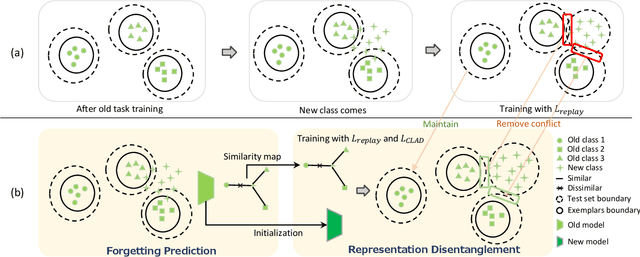
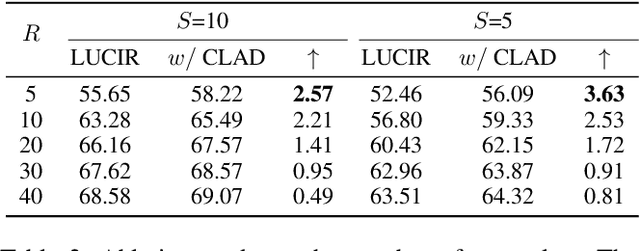
Abstract:We observe a high level of imbalance in the accuracy of different classes in the same old task for the first time. This intriguing phenomenon, discovered in replay-based Class Incremental Learning (CIL), highlights the imbalanced forgetting of learned classes, as their accuracy is similar before the occurrence of catastrophic forgetting. This discovery remains previously unidentified due to the reliance on average incremental accuracy as the measurement for CIL, which assumes that the accuracy of classes within the same task is similar. However, this assumption is invalid in the face of catastrophic forgetting. Further empirical studies indicate that this imbalanced forgetting is caused by conflicts in representation between semantically similar old and new classes. These conflicts are rooted in the data imbalance present in replay-based CIL methods. Building on these insights, we propose CLass-Aware Disentanglement (CLAD) to predict the old classes that are more likely to be forgotten and enhance their accuracy. Importantly, CLAD can be seamlessly integrated into existing CIL methods. Extensive experiments demonstrate that CLAD consistently improves current replay-based methods, resulting in performance gains of up to 2.56%.
A Revisit to the Normalized Eight-Point Algorithm and A Self-Supervised Deep Solution
Apr 21, 2023Abstract:The Normalized Eight-Point algorithm has been widely viewed as the cornerstone in two-view geometry computation, where the seminal Hartley's normalization greatly improves the performance of the direct linear transformation (DLT) algorithm. A natural question is, whether there exists and how to find other normalization methods that may further improve the performance as per each input sample. In this paper, we provide a novel perspective and make two contributions towards this fundamental problem: 1) We revisit the normalized eight-point algorithm and make a theoretical contribution by showing the existence of different and better normalization algorithms; 2) We present a deep convolutional neural network with a self-supervised learning strategy to the normalization. Given eight pairs of correspondences, our network directly predicts the normalization matrices, thus learning to normalize each input sample. Our learning-based normalization module could be integrated with both traditional (e.g., RANSAC) and deep learning framework (affording good interpretability) with minimal efforts. Extensive experiments on both synthetic and real images show the effectiveness of our proposed approach.
Free Lunch for Generating Effective Outlier Supervision
Jan 17, 2023Abstract:When deployed in practical applications, computer vision systems will encounter numerous unexpected images (\emph{{i.e.}}, out-of-distribution data). Due to the potentially raised safety risks, these aforementioned unseen data should be carefully identified and handled. Generally, existing approaches in dealing with out-of-distribution (OOD) detection mainly focus on the statistical difference between the features of OOD and in-distribution (ID) data extracted by the classifiers. Although many of these schemes have brought considerable performance improvements, reducing the false positive rate (FPR) when processing open-set images, they necessarily lack reliable theoretical analysis and generalization guarantees. Unlike the observed ways, in this paper, we investigate the OOD detection problem based on the Bayes rule and present a convincing description of the reason for failures encountered by conventional classifiers. Concretely, our analysis reveals that refining the probability distribution yielded by the vanilla neural networks is necessary for OOD detection, alleviating the issues of assigning high confidence to OOD data. To achieve this effortlessly, we propose an ultra-effective method to generate near-realistic outlier supervision. Extensive experiments on large-scale benchmarks reveal that our proposed \texttt{BayesAug} significantly reduces the FPR95 over 12.50\% compared with the previous schemes, boosting the reliability of machine learning systems. The code will be made publicly available.
Searching Dense Point Correspondences via Permutation Matrix Learning
Oct 26, 2022



Abstract:Although 3D point cloud data has received widespread attentions as a general form of 3D signal expression, applying point clouds to the task of dense correspondence estimation between 3D shapes has not been investigated widely. Furthermore, even in the few existing 3D point cloud-based methods, an important and widely acknowledged principle, i.e . one-to-one matching, is usually ignored. In response, this paper presents a novel end-to-end learning-based method to estimate the dense correspondence of 3D point clouds, in which the problem of point matching is formulated as a zero-one assignment problem to achieve a permutation matching matrix to implement the one-to-one principle fundamentally. Note that the classical solutions of this assignment problem are always non-differentiable, which is fatal for deep learning frameworks. Thus we design a special matching module, which solves a doubly stochastic matrix at first and then projects this obtained approximate solution to the desired permutation matrix. Moreover, to guarantee end-to-end learning and the accuracy of the calculated loss, we calculate the loss from the learned permutation matrix but propagate the gradient to the doubly stochastic matrix directly which bypasses the permutation matrix during the backward propagation. Our method can be applied to both non-rigid and rigid 3D point cloud data and extensive experiments show that our method achieves state-of-the-art performance for dense correspondence learning.
 Add to Chrome
Add to Chrome Add to Firefox
Add to Firefox Add to Edge
Add to Edge